
How to Use 4 Channel Relay Module: Examples, Pinouts, and Specs
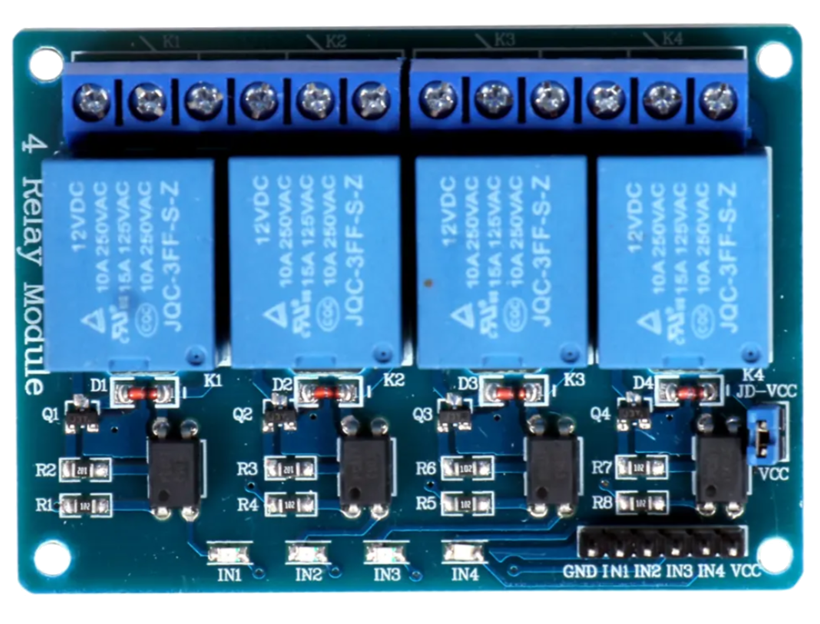
 Design with 4 Channel Relay Module in Cirkit Designer
Design with 4 Channel Relay Module in Cirkit DesignerIntroduction
The 4 Channel Relay Module is an electronic component designed to control up to four separate high-power devices using low-voltage control signals. It acts as an interface between microcontrollers (e.g., Arduino, Raspberry Pi) and high-voltage devices, enabling safe and efficient switching. The module typically features opto-isolation to protect the control circuit from high-voltage spikes, ensuring safety and reliability.
Explore Projects Built with 4 Channel Relay Module
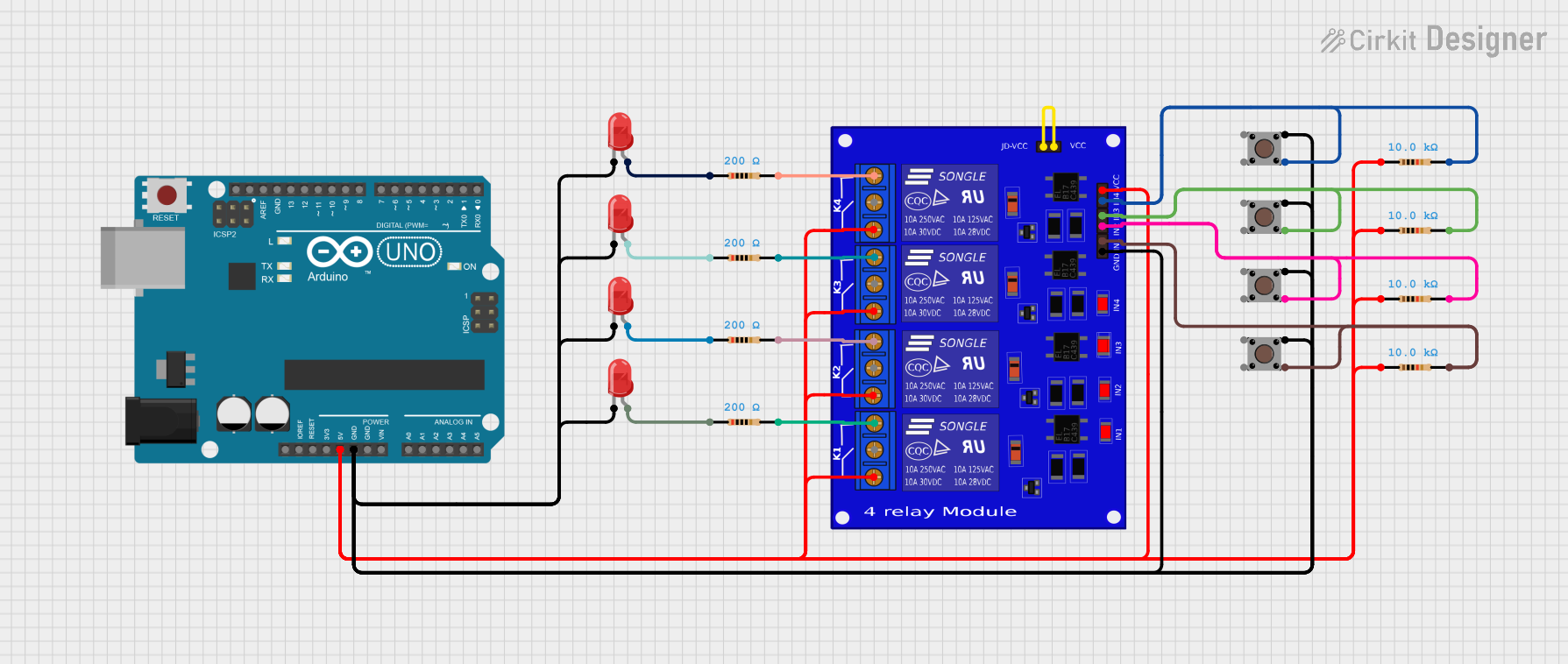
 Open Project in Cirkit Designer
Open Project in Cirkit Designer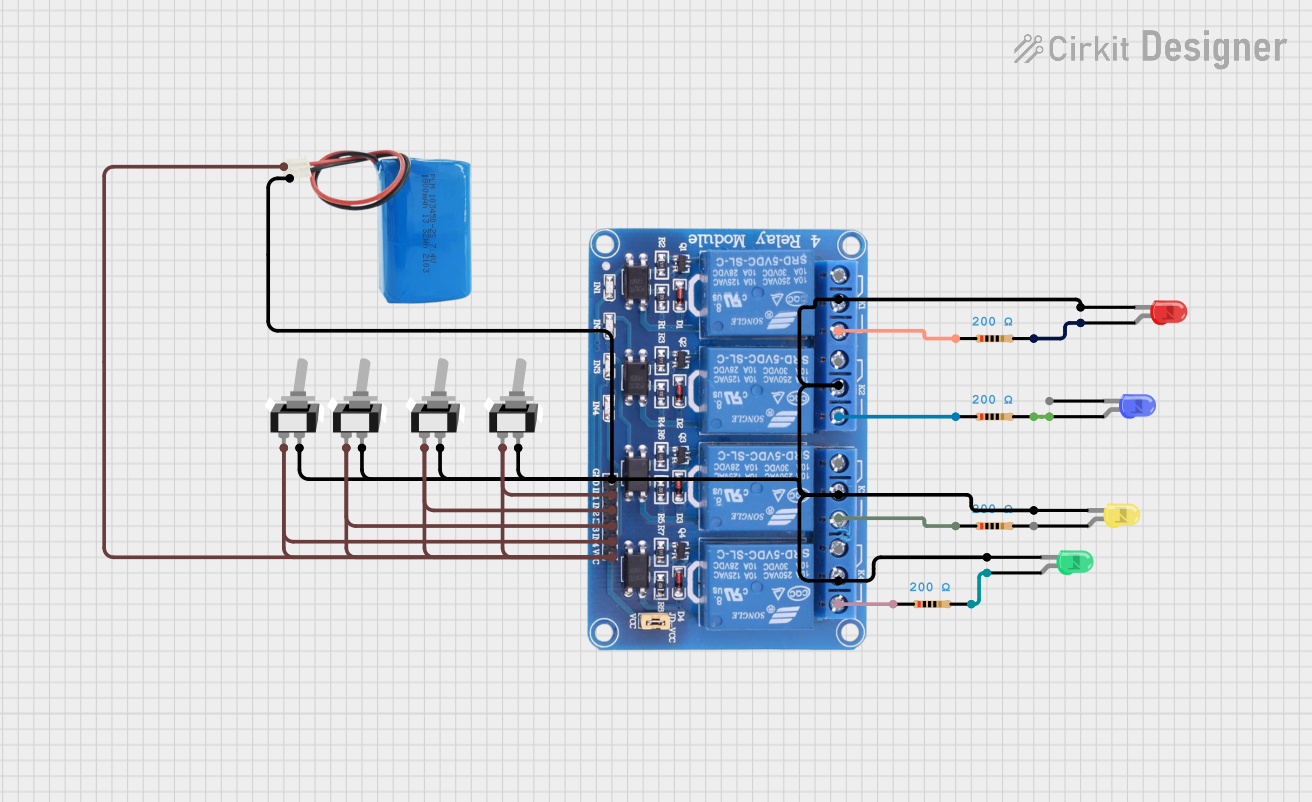
 Open Project in Cirkit Designer
Open Project in Cirkit Designer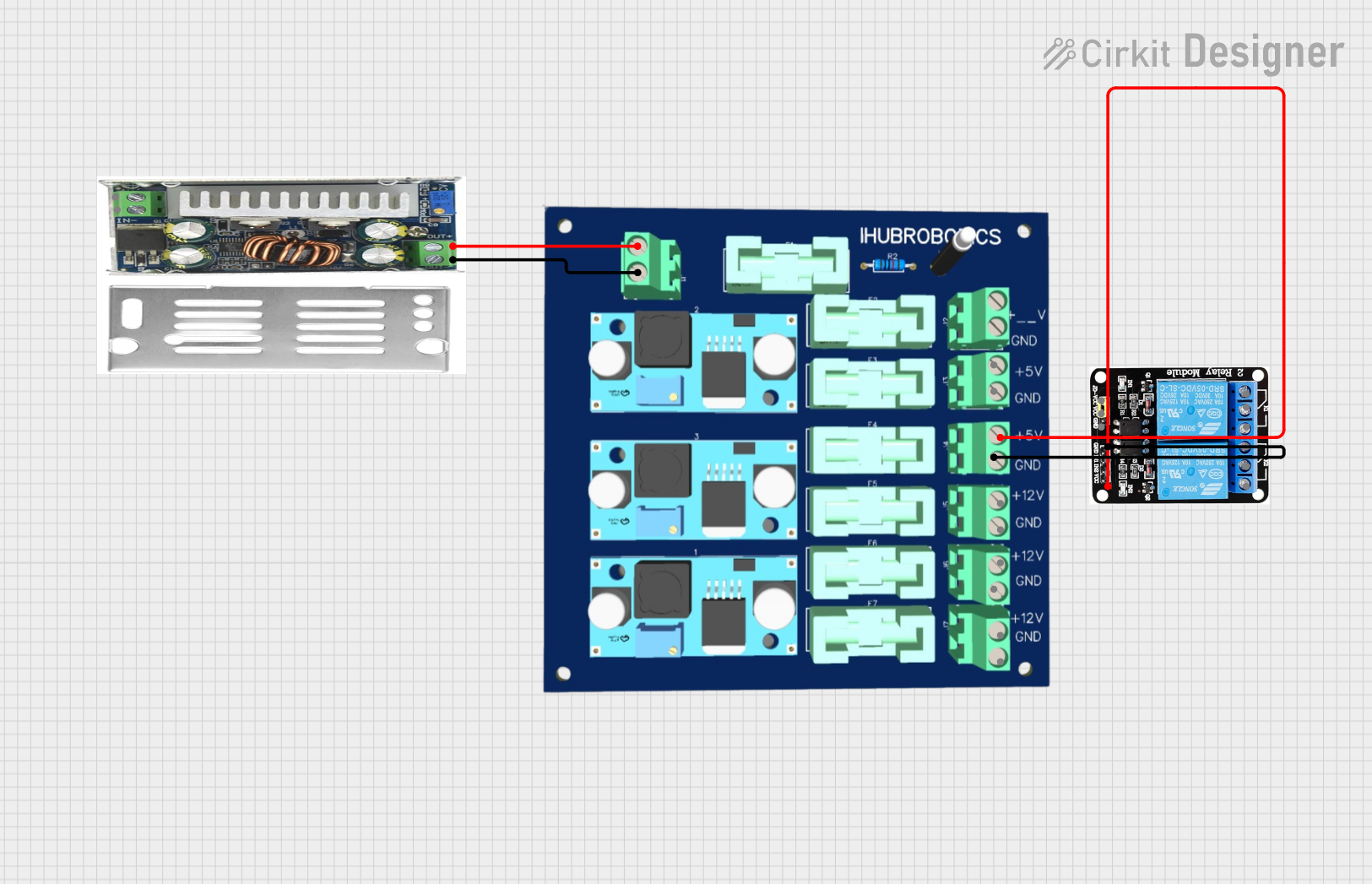
 Open Project in Cirkit Designer
Open Project in Cirkit Designer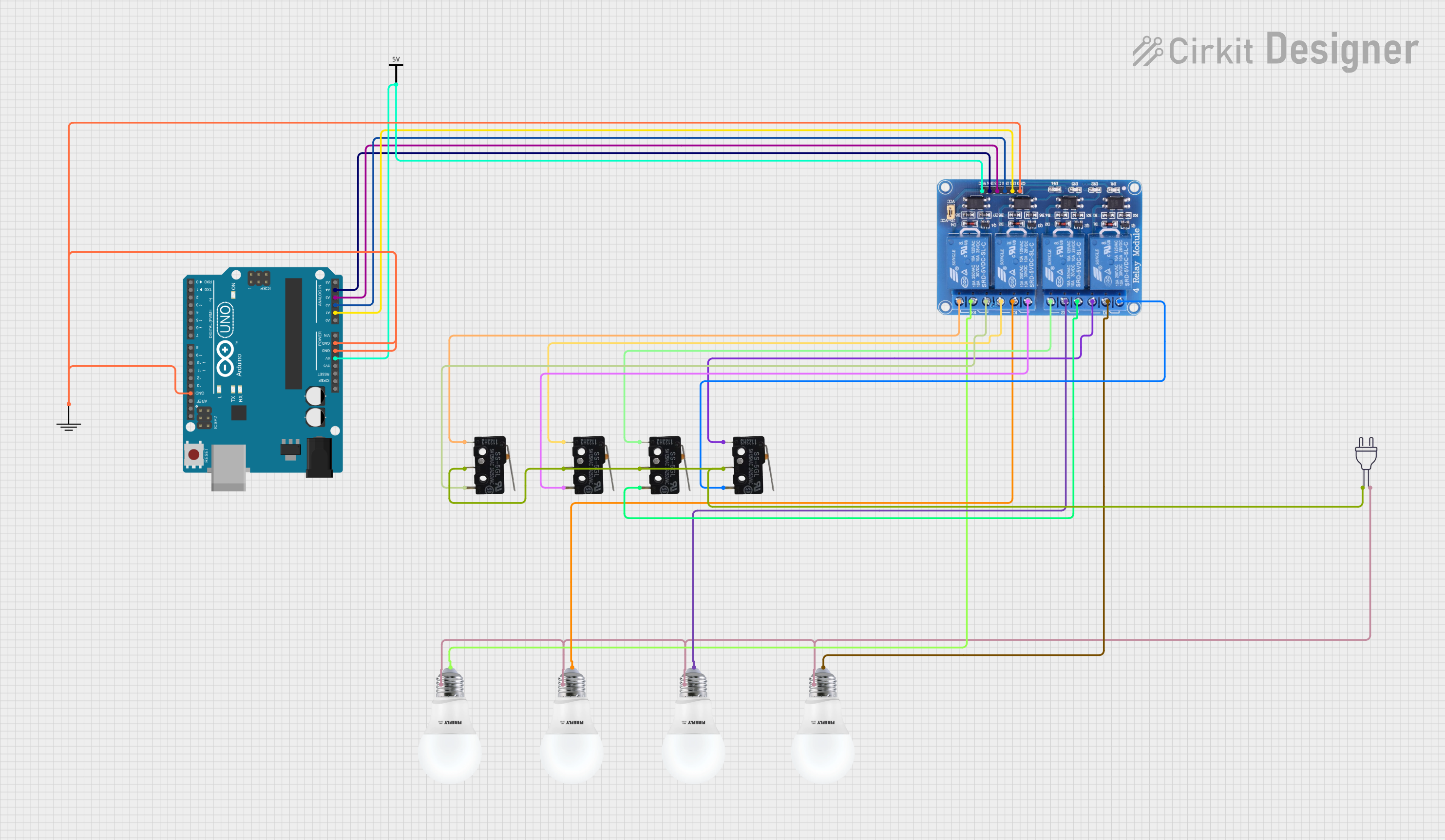
 Open Project in Cirkit Designer
Open Project in Cirkit DesignerExplore Projects Built with 4 Channel Relay Module

 Open Project in Cirkit Designer
Open Project in Cirkit Designer
 Open Project in Cirkit Designer
Open Project in Cirkit Designer
 Open Project in Cirkit Designer
Open Project in Cirkit Designer
 Open Project in Cirkit Designer
Open Project in Cirkit DesignerCommon Applications and Use Cases
- Home Automation: Controlling lights, fans, and other household appliances.
- Industrial Control: Managing motors, pumps, and other industrial equipment.
- Robotics: Switching actuators or other high-power components.
- IoT Projects: Enabling remote control of devices via the internet.
- Prototyping: Testing and developing circuits that require high-power switching.
Technical Specifications
The following are the key technical details of the 4 Channel Relay Module:
| Parameter | Specification |
|---|---|
| Operating Voltage | 5V DC |
| Trigger Voltage | 3.3V to 5V (compatible with most microcontrollers) |
| Relay Type | SPDT (Single Pole Double Throw) |
| Maximum Load (AC) | 250V AC @ 10A |
| Maximum Load (DC) | 30V DC @ 10A |
| Isolation Method | Opto-isolator |
| Dimensions | ~75mm x 55mm x 20mm |
| Indicator LEDs | One LED per channel (indicates relay state) |
| Control Signal Logic | Active Low |
Pin Configuration and Descriptions
The 4 Channel Relay Module has the following pin layout:
Input Pins (Control Side)
| Pin Name | Description |
|---|---|
| VCC | Power supply for the module (5V DC). |
| GND | Ground connection. |
| IN1 | Control signal for Relay 1 (Active Low). |
| IN2 | Control signal for Relay 2 (Active Low). |
| IN3 | Control signal for Relay 3 (Active Low). |
| IN4 | Control signal for Relay 4 (Active Low). |
Output Pins (Relay Side)
Each relay has three output terminals:
| Terminal | Description |
|---|---|
| NO (Normally Open) | Open circuit when the relay is inactive. Closes when activated. |
| NC (Normally Closed) | Closed circuit when the relay is inactive. Opens when activated. |
| COM (Common) | Common terminal for the relay. |
Usage Instructions
How to Use the 4 Channel Relay Module in a Circuit
- Power the Module: Connect the VCC pin to a 5V DC power source and the GND pin to ground.
- Connect Control Signals: Use digital output pins from a microcontroller (e.g., Arduino) to connect to the IN1, IN2, IN3, and IN4 pins. Ensure the control signals are active low.
- Connect the Load: For each relay, connect the high-power device to the NO, NC, and COM terminals as required:
- For devices that should turn on when the relay is activated, use the NO and COM terminals.
- For devices that should turn off when the relay is activated, use the NC and COM terminals.
- Write Control Code: Program the microcontroller to send signals to the IN pins to activate or deactivate the relays.
Important Considerations and Best Practices
- Power Supply: Ensure the module is powered with a stable 5V DC supply. Avoid exceeding the voltage rating.
- Isolation: Use opto-isolation to protect the microcontroller from high-voltage spikes.
- Load Ratings: Do not exceed the maximum load ratings (250V AC @ 10A or 30V DC @ 10A) to prevent damage.
- Active Low Logic: Remember that the relays are triggered by a LOW signal on the IN pins.
- Safety: Always disconnect power when wiring high-voltage devices to the relay module.
Example Code for Arduino UNO
Below is an example code snippet to control the 4 Channel Relay Module using an Arduino UNO:
// Define relay control pins
#define RELAY1 2 // Pin connected to IN1
#define RELAY2 3 // Pin connected to IN2
#define RELAY3 4 // Pin connected to IN3
#define RELAY4 5 // Pin connected to IN4
void setup() {
// Set relay pins as outputs
pinMode(RELAY1, OUTPUT);
pinMode(RELAY2, OUTPUT);
pinMode(RELAY3, OUTPUT);
pinMode(RELAY4, OUTPUT);
// Initialize all relays to OFF (HIGH state)
digitalWrite(RELAY1, HIGH);
digitalWrite(RELAY2, HIGH);
digitalWrite(RELAY3, HIGH);
digitalWrite(RELAY4, HIGH);
}
void loop() {
// Example: Turn on Relay 1 for 2 seconds, then turn it off
digitalWrite(RELAY1, LOW); // Activate Relay 1
delay(2000); // Wait for 2 seconds
digitalWrite(RELAY1, HIGH); // Deactivate Relay 1
delay(2000); // Wait for 2 seconds
// Repeat similar logic for other relays as needed
}
Troubleshooting and FAQs
Common Issues and Solutions
Relays Not Activating:
- Cause: Insufficient power supply or incorrect wiring.
- Solution: Ensure the module is powered with 5V DC and the GND is connected properly.
Microcontroller Resetting When Relays Activate:
- Cause: Voltage spikes or insufficient power supply to the microcontroller.
- Solution: Use a separate power supply for the relay module and microcontroller. Add a flyback diode across the relay coil if not already present.
LED Indicators Not Lighting Up:
- Cause: Faulty module or incorrect control signals.
- Solution: Verify the control signals are active low and check the module for damage.
Load Not Switching Properly:
- Cause: Incorrect wiring of the load to the relay terminals.
- Solution: Double-check the connections to the NO, NC, and COM terminals.
FAQs
Q: Can I use a 3.3V microcontroller with this module?
A: Yes, the module is compatible with 3.3V control signals, but ensure the power supply to the module is 5V.Q: Can I control DC motors with this module?
A: Yes, as long as the motor's voltage and current ratings are within the relay's specifications.Q: Is it safe to use this module with 220V AC appliances?
A: Yes, but ensure proper insulation and follow safety precautions when working with high voltages.Q: Can I use fewer than 4 relays?
A: Yes, you can use only the required number of relays and leave the unused channels unconnected.